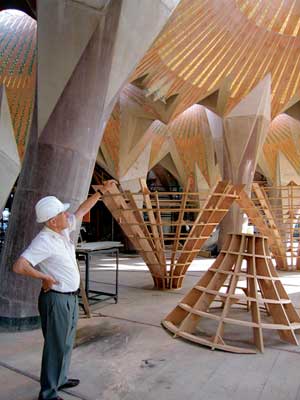An End in Sight for a Centuries-Old Building Project?
Gaudà did, however, draw on the knowledge he gained from earlier projects: in particular, the crypt for the Colònia Güell chapel, another unfinished religious structure built for a worker's village outside Barcelona. It was for this project that Gaudà developed his famous hanging model-one of the first known adaptive or parametric models-using small bags of birdshot attached to an adjustable web of string. His invention allowed gravity to inform the structural design. But while Gaudà created the somewhat irregular, circular plan for this chapel, he had to work within a Gothic Revival Latin Cross plan already in place at the Sagrada FamÃlia. "If you liberated the design to allow gravity to truly inform it, it wouldn't necessarily conform to bays of equal length, and the proportional system of the Sagrada FamÃlia would have been compromised," says Burry. "But Gaudà used the same principle, relying on the static resolution of forces. The lessons he learned from the Colònia Güell chapel were applied to the Sagrada FamÃlia to the extent that the columns, where possible, are aligned to take forces axially, and that accounts for the branching."
 |
Architectural director Jordi Photo: Josephine Minutillo (left); |
 |
|
Â
It also accounts for the fact that none of the columns in the Sagrada FamÃlia are completely vertical. Even the soaring, treelike columns that run the length of the central nave (reaching heights of close to 150 feet) are slightly inclined. While none of these columns were built before GaudÃ's death, existing plaster models show GaudÃ's experiments with counter-rotated columns (whose profile transforms from circular to square to star-shaped along its length) and structural trees (whose upper branches carry and distribute the load from the vaults, thus eliminating the need for exterior buttressing like most Gothic cathedrals). Just prior to branching, the column forms a node, or knot, which is based on a variety of forms varying from ellipsoids to more abstract formations.
The columns' upper branches also serve to connect with the ceiling vaults in a novel way. "Gaudà sought a continuity between the columns and vaults in parabolic and spiral column forms," says Jordi FaulÃ, assistant head architect. "He did not achieve this with total success until he created the counter-rotated double-helix and adopted the hyperboloid for the skylights of the vaults." The vault is organized in concentric circles around a large central hyperboloid which is 13 feet in diameter. Columns and skylights alternate in these concentric circles. In planning the vaults of the central nave, which were built during the 1990s, Gaudà used regular surfaces based on hyperboloids to form the oculi and capitals, and hyperbolic paraboloids for the transitional elements between them.
The hyperboloid is one of several ruled surfaces-surfaces, like cones and cylinders, generated by connecting line segments between corresponding points-Gaudà employed at the Sagrada FamÃlia. (Similar geometries can be found at Colònia Güell, where he used hyperbolic paraboloids extensively.) But Gaudà was working without precedent, never having seen a building with a significant array of ruled surfaces. He also did not explain in sufficient detail how he intended to translate them into built form, leaving his successors with a substantial challenge-one that has been met by the use of parametric modeling.









